Enhancing Neonatal Incubator Energy Management and Monitoring through IoT-Enabled CNN-LSTM Combination Predictive Model
Abstract
:1. Introduction
- web application for real-time monitoring and control;
- visualization of the temperature data distribution inside the incubator;
- prototype of an electronic hardware incubator; and
- hybrid model utilizing 1D-CNN and LSTM methods for predicting energy consumption models.
2. Related Works
3. Materials and Methods
3.1. System Overview
3.2. Electronic Design
| Algorithm 1: Hardware system |
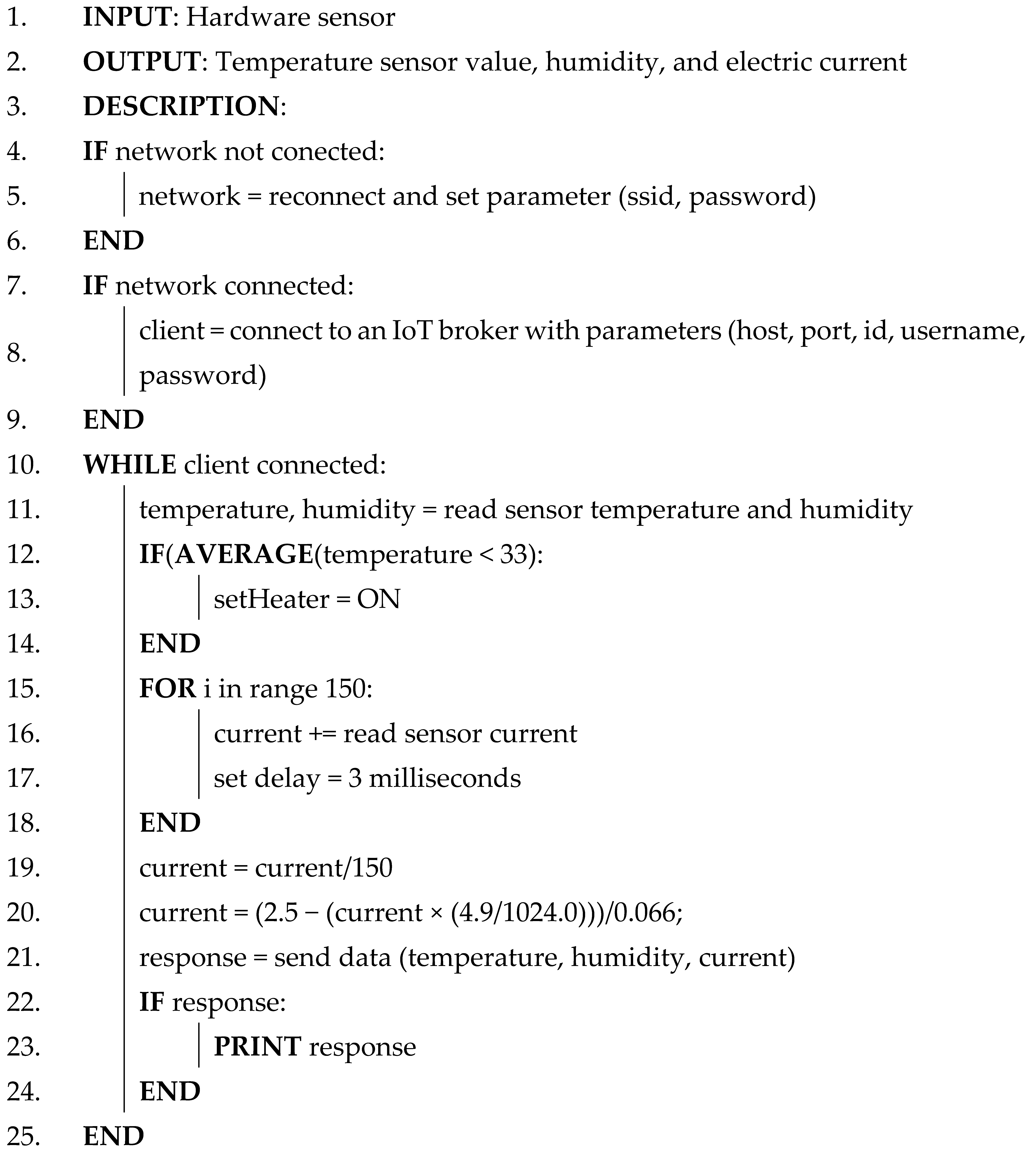 |
3.3. Network Design
3.4. Data Management
3.4.1. Database
| Algorithm 2: Data management |
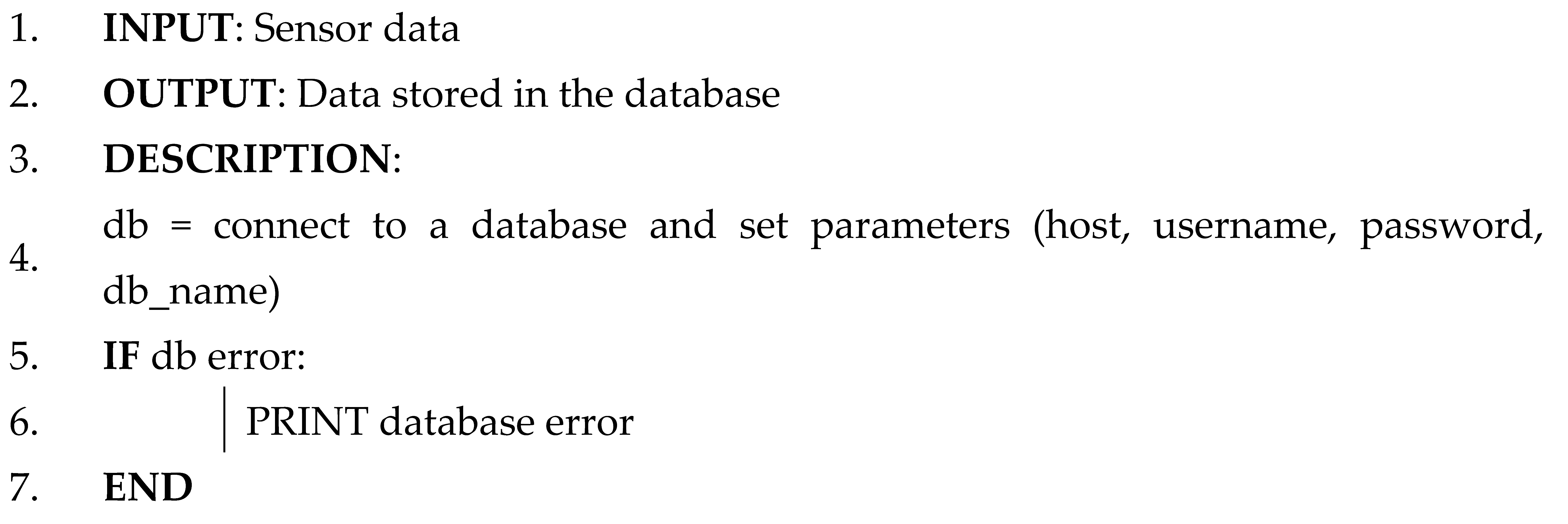 |
 |
3.4.2. Dataset Description
3.5. Software Design
| Algorithm 3: Web application |
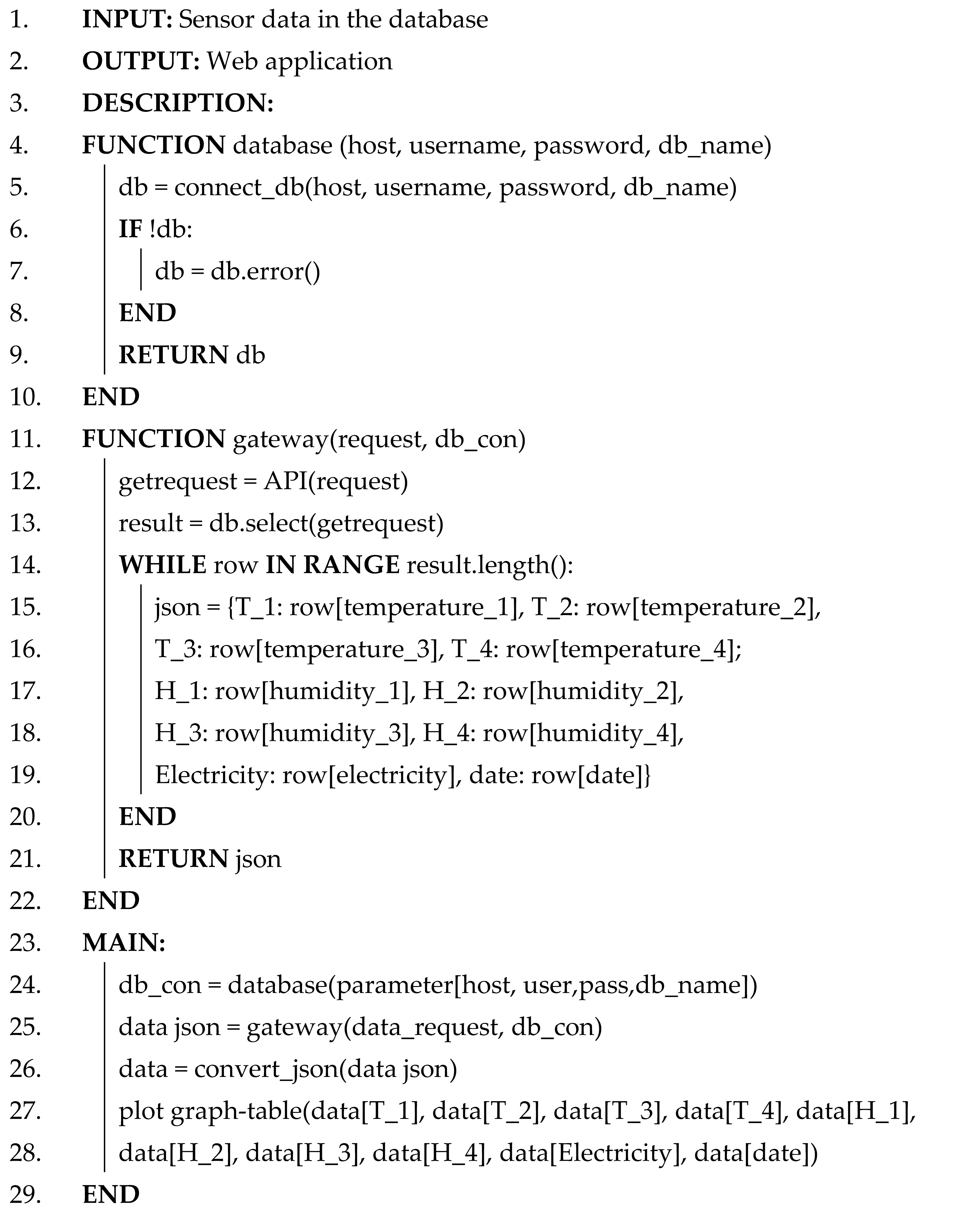 |
3.6. Model Design
3.6.1. Preprocessing
3.6.2. Long Short-Term Memory (LSTM)
3.6.3. Convolutional Neural Network (CNN)
3.6.4. CNN-LSTM
3.6.5. Activation Function
3.6.6. Evaluation Performance Model
3.6.7. Data Visualization
3.7. Output Design
- A web application for real-time monitoring and control: the first output is a web application designed for monitoring real-time data from sensors inside the incubator, such as temperature, humidity, electrical current, and heater status. This application provides real-time information to medical staff or the patient’s family.
- Visualization of the temperature data distribution inside the incubator: the second output is the visualization of the temperature data distribution within the incubator. This visualization provides insights into temperature fluctuations in different areas within the incubator, enabling the identification of areas that may require further attention.
- A prototype of an electronic hardware incubator: the third output is a prototype product of an incubator equipped with several hardware modules such as sensors, actuators, and microcontrollers. This prototype is a tangible representation of the designed incubator by integrating various hardware components and technologies.
- Energy consumption prediction models: the final output is an energy consumption prediction model. This model can assist in optimizing resource usage by making predictions for more efficient energy consumption. The research’s outcomes are expected to improve neonatal management and care.
4. Results and Discussion
5. Conclusions
Author Contributions
Funding
Institutional Review Board Statement
Informed Consent Statement
Data Availability Statement
Acknowledgments
Conflicts of Interest
References
- Fortino, G.; Savaglio, C.; Spezzano, G.; Zhou, M. Internet of Things as System of Systems: A Review of Methodologies, Frameworks, Platforms, and Tools. IEEE Trans. Syst. Man Cybern. Syst. 2021, 51, 223–236. [Google Scholar] [CrossRef]
- Wozniak, M.; Zielonka, A.; Sikora, A.; Piran, M.J.; Alamri, A. 6G-Enabled Iot Home Environment Control Using Fuzzy Rules. IEEE Internet Things J. 2021, 8, 5442–5452. [Google Scholar] [CrossRef]
- Fortino, G.; Russo, W.; Savaglio, C.; Viroli, M.; Zhou, M. Modeling Opportunistic IoT Services in Open IoT Ecosystems. CEUR Workshop Proc. 2017, 1867, 90–95. [Google Scholar]
- Krohkaew, J.; Nilaphruek, P.; Witthayawiroj, N.; Uapipatanakul, S.; Thwe, Y.; Crisnapati, P.N. Thailand Raw Water Quality Dataset Analysis and Evaluation. Data 2023, 8, 141. [Google Scholar] [CrossRef]
- De Rango, F.; Potrino, G.; Tropea, M.; Fazio, P. Energy-Aware Dynamic Internet of Things Security System Based on Elliptic Curve Cryptography and Message Queue Telemetry Transport Protocol for Mitigating Replay Attacks. Pervasive Mob. Comput. 2020, 61, 101105. [Google Scholar] [CrossRef]
- Kapen, P.T.; Mohamadou, Y.; Momo, F.; Jauspin, D.K.; Kanmagne, N.; Jordan, D.D. Development of a Neonatal Incubator with Phototherapy, Biometric Fingerprint Reader, Remote Monitoring, and Heart Rate Control Adapted for Developing Countries Hospitals. J. Neonatal Nurs. 2019, 25, 298–303. [Google Scholar] [CrossRef]
- Alimuddin, A.; Arafiyah, R.; Saraswati, I.; Alfanz, R.; Hasudungan, P.; Taufik, T. Development and Performance Study of Temperature and Humidity Regulator in Baby Incubator Using Fuzzy-Pid Hybrid Controller. Energies 2021, 14, 14206505. [Google Scholar] [CrossRef]
- Cay, G.; Solanki, D.; Rumon, M.A.A.; Ravichandran, V.; Hoffman, L.; Laptook, A.; Padbury, J.; Salisbury, A.L.; Mankodiya, K. NeoWear: An IoT-Connected e-Textile Wearable for Neonatal Medical Monitoring. Pervasive Mob. Comput. 2022, 86, 101679. [Google Scholar] [CrossRef]
- Aya-Parra, P.A.; Rodriguez-Orjuela, A.J.; Rodriguez Torres, V.; Cordoba Hernandez, N.P.; Martinez Castellanos, N.; Sarmiento-Rojas, J. Monitoring System for Operating Variables in Incubators in the Neonatology Service of a Highly Complex Hospital through the Internet of Things (IoT). Sensors 2023, 23, 5719. [Google Scholar] [CrossRef]
- Essa, M.E.-S.M.; El-shafeey, A.M.; Omar, A.H.; Fathi, A.E.; Maref, A.S.A.E.; Lotfy, J.V.W.; El-Sayed, M.S. Reliable Integration of Neural Network and Internet of Things for Forecasting, Controlling, and Monitoring of Experimental Building Management System. Sustainability 2023, 15, 2168. [Google Scholar] [CrossRef]
- Hadi, W.N.H.W.A.; Rashid, R.A.; Sarijari, M.A.; Hamid, S.Z.A.; Muhammad, N.A. Machine Learning Bill Prediction for IoT-Based Utility Management System. In Proceedings of the 2022 IEEE 6th International Symposium on Telecommunication Technologies (ISTT), Johor Bahru, Malaysia, 14–16 November 2022; pp. 74–78. [Google Scholar]
- Dinçer, K.; Semczuk, M. Open-Source Magnetometer for Characterizing Magnetic Fields in Ultracold Experiments. Appl. Sci. 2023, 13, 10620. [Google Scholar] [CrossRef]
- Rouillard, J.; Vannobel, J.-M. Multimodal Interaction for Cobot Using MQTT. Multimodal Technol. Interact. 2023, 7, 78. [Google Scholar] [CrossRef]
- Woźniak, M.; Szczotka, J.; Sikora, A.; Zielonka, A. Fuzzy Logic Type-2 Intelligent Moisture Control System. Expert Syst. Appl. 2024, 238, 121581. [Google Scholar] [CrossRef]
- Guo, S.; Mao, X.; Dai, D.; Wang, Z.; Chen, D.; Wang, S. Embedded Yolo-Fastest V2-Based 3D Reconstruction and Size Prediction of Grain Silo-Bag. Remote Sens. 2023, 15, 4846. [Google Scholar] [CrossRef]
- Siddharthan, H.; Deepa, T.; Chandhar, P. SENMQTT-SET: An Intelligent Intrusion Detection in IoT-MQTT Networks Using Ensemble Multi Cascade Features. IEEE Access 2022, 10, 33095–33110. [Google Scholar] [CrossRef]
- Barreto, M.V.S.; Barra, W.; Rocha, E.M.; Nogueira, F.G.; Marcillo, K.L.; De Medeiros, R.L.P.; Abreu, T.W.M.; Alves, M.S. Apache Dynamic Update for Feedback Control of Computing Resources. IEEE Access 2019, 7, 55861–55872. [Google Scholar] [CrossRef]
- Hernández-Gutiérrez, C.A.; Delgado-del-Carpio, M.; Zebadúa-Chavarría, L.A.; Hernández-de-León, H.R.; Escobar-Gómez, E.N.; Quevedo-López, M. IoT-Enabled System for Detection, Monitoring, and Tracking of Nuclear Materials. Electronics 2023, 12, 3042. [Google Scholar] [CrossRef]
- Jara Ochoa, H.J.; Peña, R.; Ledo Mezquita, Y.; Gonzalez, E.; Camacho-Leon, S. Comparative Analysis of Power Consumption between MQTT and HTTP Protocols in an IoT Platform Designed and Implemented for Remote Real-Time Monitoring of Long-Term Cold Chain Transport Operations. Sensors 2023, 23, 4896. [Google Scholar] [CrossRef]
- Dinculeană, D.; Cheng, X. Vulnerabilities and Limitations of MQTT Protocol Used between IoT Devices. Appl. Sci. 2019, 9, 848. [Google Scholar] [CrossRef]
- Alhussein, M.; Aurangzeb, K.; Haider, S.I. Hybrid CNN-LSTM Model for Short-Term Individual Household Load Forecasting. IEEE Access 2020, 8, 180544–180557. [Google Scholar] [CrossRef]
- Peng, Y.; Shen, H.; Tang, X.; Zhang, S.; Zhao, J.; Liu, Y.; Nie, Y. Energy Consumption Optimization for Heating, Ventilation and Air Conditioning Systems Based on Deep Reinforcement Learning. IEEE Access 2023, 11, 88265–88277. [Google Scholar] [CrossRef]
- El-Hassan, F.T.; Ionescu, D. Design and Implementation of a Hardware Versatile Publish-Subscribe Architecture for the Internet of Things. IEEE Access 2018, 6, 31872–31890. [Google Scholar] [CrossRef]
- Singh, T.; Solanki, A.; Sharma, S.K.; Jhanjhi, N.Z.; Ghoniem, R.M. Grey Wolf Optimization Based CNN-LSTM Network for the Prediction of Energy Consumption in Smart Home Environment. IEEE Access 2023, 11, 114917–114935. [Google Scholar] [CrossRef]
- Govarthan, R.; Hariharan, S.; Mary, T.B.; Paul, J.J.; Manimekalai, M.A.P.; Thilagavathi, K. IoT Based Health Monitoring and Tracking in Combat. In Proceedings of the 2023 4th International Conference on Signal Processing and Communication (ICSPC), Coimbatore, India, 6–8 September 2023; pp. 297–301. [Google Scholar]
- Widura, A.; Hadiatna, F.; Anugerah, D. Fuzzy-Based Smart Farming and Consumed Energy Comparison Using the Internet of Things. IEEE Access 2023, 11, 69241–69251. [Google Scholar] [CrossRef]
- Lalitha, K.; Ramya, G.; Shunmugathammal, M. AI-Based Safety Helmet for Mining Workers Using IoT Technology and ARM Cortex-M. IEEE Sens. J. 2023, 23, 21355–21362. [Google Scholar] [CrossRef]
- El-Leathey, L.-A.; Anghelita, P.; Constantin, A.-I.; Circiumaru, G.; Chihaia, R.-A. System for Indoor Comfort and Health Monitoring Tested in Office Building Environment. Appl. Sci. 2023, 13, 11360. [Google Scholar] [CrossRef]
- Tran, M.Q.; Elsisi, M.; Liu, M.K.; Vu, V.Q.; Mahmoud, K.; Darwish, M.M.F.; Abdelaziz, A.Y.; Lehtonen, M. Reliable Deep Learning and IoT-Based Monitoring System for Secure Computer Numerical Control Machines Against Cyber-Attacks With Experimental Verification. IEEE Access 2022, 10, 23186–23197. [Google Scholar] [CrossRef]
- Ling, Z.; Gao, C.; Sano, C.; Toe, C.; Li, Z.; Fu, X. STIR: A Smart and Trustworthy IoT System Interconnecting Legacy IR Devices. IEEE Internet Things J. 2020, 7, 3958–3967. [Google Scholar] [CrossRef]
- Győrödi, C.A.; Turtureanu, T.; Győrödi, R.Ş.; Zmaranda, D.R. Implementing a Synchronization Method between a Relational and a Non-Relational Database. Big Data Cogn. Comput. 2023, 7, 153. [Google Scholar] [CrossRef]
- World Health Organization Research; Reproductive Health. Managing Newborn Problems: A Guide for Doctors, Nurses, and Midwives; Integrated Management of Pregnancy and Childbirth; World Health Organization: Geneva, Switzerland, 2003; ISBN 9789241546225. [Google Scholar]
- Wardana, I.N.K.; Gardner, J.W.; Fahmy, S.A. Optimising Deep Learning at the Edge for Accurate Hourly Air Quality Prediction. Sensors 2021, 21, 1064. [Google Scholar] [CrossRef]
- Wardana, I.N.K.; Gardner, J.W.; Fahmy, S.A. Estimation of Missing Air Pollutant Data Using a Spatiotemporal Convolutional Autoencoder. Neural Comput. Appl. 2022, 34, 16129–16154. [Google Scholar] [CrossRef]
- Wen, S.; Jia, P.; Yang, P.; Hu, C. Squill: Testing DBMS with Correctness Feedback and Accurate Instantiation. Appl. Sci. 2023, 13, 2519. [Google Scholar] [CrossRef]
- Babovic, Z.B.; Protic, J.; Milutinovic, V. Web Performance Evaluation for Internet of Things Applications. IEEE Access 2016, 4, 6974–6992. [Google Scholar] [CrossRef]
- Brito, T.; Ferreira, M.; Monteiro, M.; Lopes, P.; Barros, M.; Santos, J.F.; Santos, N. Study of JavaScript Static Analysis Tools for Vulnerability Detection in Node.Js Packages. IEEE Trans. Reliab. 2023, 72, 1324–1339. [Google Scholar] [CrossRef]
- Elmannai, W.; Elleithy, K.; Benz, A.A.; DeAngelis, A.C.; Weaver, N. An Enhanced Piezoelectric-Generated Power Technique for Qi Wireless Charging. Clean Technol. 2023, 5, 94–115. [Google Scholar] [CrossRef]
- Ahsan, M.M.; Mahmud, M.A.P.; Saha, P.K.; Gupta, K.D.; Siddique, Z. Effect of Data Scaling Methods on Machine Learning Algorithms and Model Performance. Technologies 2021, 9, 52. [Google Scholar] [CrossRef]
- Aaryan, A.; Kanisha, B. Forecasting Stock Market Price Using LSTM-RNN. In Proceedings of the 2022 2nd International Conference on Advance Computing and Innovative Technologies in Engineering (ICACITE), Greater Noida, India, 28–29 April 2022; pp. 1557–1560. [Google Scholar]
- Hochreiter, S.; Schmidhuber, J. Long Short-Term Memory. Neural Comput. 1997, 9, 1735–1780. [Google Scholar] [CrossRef] [PubMed]
- Lawal, A.; Rehman, S.; Alhems, L.M.; Alam, M.M. Wind Speed Prediction Using Hybrid 1D CNN and BLSTM Network. IEEE Access 2021, 9, 156672–156679. [Google Scholar] [CrossRef]
- Wang, X.; Xia, M.; Deng, W. MSRN-Informer: Time Series Prediction Model Based on Multi-Scale Residual Network. IEEE Access 2023, 11, 65059–65065. [Google Scholar] [CrossRef]
- Zhao, J.; Mao, X.; Chen, L. Speech Emotion Recognition Using Deep 1D & 2D CNN LSTM Networks. Biomed. Signal Process Control 2019, 47, 312–323. [Google Scholar] [CrossRef]
- Mitiche, I.; Nesbitt, A.; Conner, S.; Boreham, P.; Morison, G. 1D-CNN Based Real-Time Fault Detection System for Power Asset Diagnostics. IET Gener. Transm. Distrib. 2020, 14, 5766–5773. [Google Scholar] [CrossRef]
- Han, Z.; Cui, B.; Xu, L.; Wang, J.; Guo, Z. Coupling LSTM and CNN Neural Networks for Accurate Carbon Emission Prediction in 30 Chinese Provinces. Sustainability 2023, 15, 13934. [Google Scholar] [CrossRef]
- Zhang, C.; Chen, P.; Jiang, F.; Xie, J.; Yu, T. Fault Diagnosis of Nuclear Power Plant Based on Sparrow Search Algorithm Optimized CNN-LSTM Neural Network. Energies 2023, 16, 2934. [Google Scholar] [CrossRef]
- Rubasinghe, O.; Zhang, X.; Chau, T.K.; Chow, Y.; Fernando, T.; Iu, H.H.C. A Novel Sequence to Sequence Data Modelling Based CNN-LSTM Algorithm for Three Years Ahead Monthly Peak Load Forecasting. IEEE Trans. Power Syst. 2023, 1–15. [Google Scholar] [CrossRef]
- Jain, R.; Semwal, V.B. A Novel Feature Extraction Method for Preimpact Fall Detection System Using Deep Learning and Wearable Sensors. IEEE Sens. J. 2022, 22, 22943–22951. [Google Scholar] [CrossRef]
- Lee, S.Y.; Byeon, S.; Kim, H.S.; Jin, H.; Lee, S. Deep Learning-Based Phase Prediction of High-Entropy Alloys: Optimization, Generation, and Explanation. Mater. Des. 2021, 197, 109260. [Google Scholar] [CrossRef]
- Chicco, D.; Warrens, M.J.; Jurman, G. The Coefficient of Determination R-Squared Is More Informative than SMAPE, MAE, MAPE, MSE and RMSE in Regression Analysis Evaluation. PeerJ Comput. Sci. 2021, 7, e263. [Google Scholar] [CrossRef]
- Hodson, T.O. Root-Mean-Square Error (RMSE) or Mean Absolute Error (MAE): When to Use Them or Not. Geosci. Model Dev. 2022, 15, 5481–5487. [Google Scholar] [CrossRef]
- Embarak, O. Data Analysis and Visualization Using Python: Analyze Data to Create Visualizations for BI Systems; Apress: New York, NY, USA, 2018; ISBN 9781484241097. [Google Scholar]
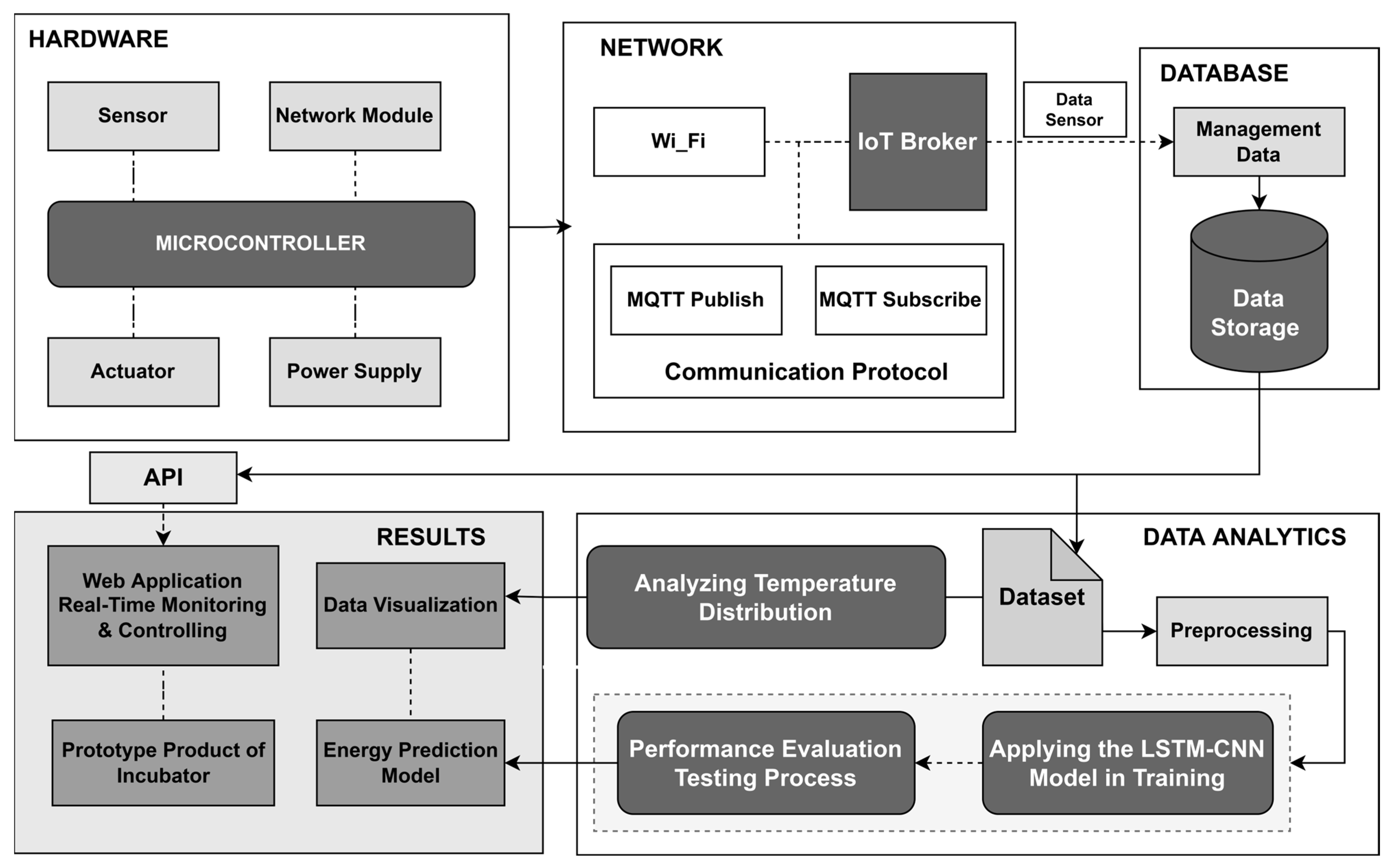
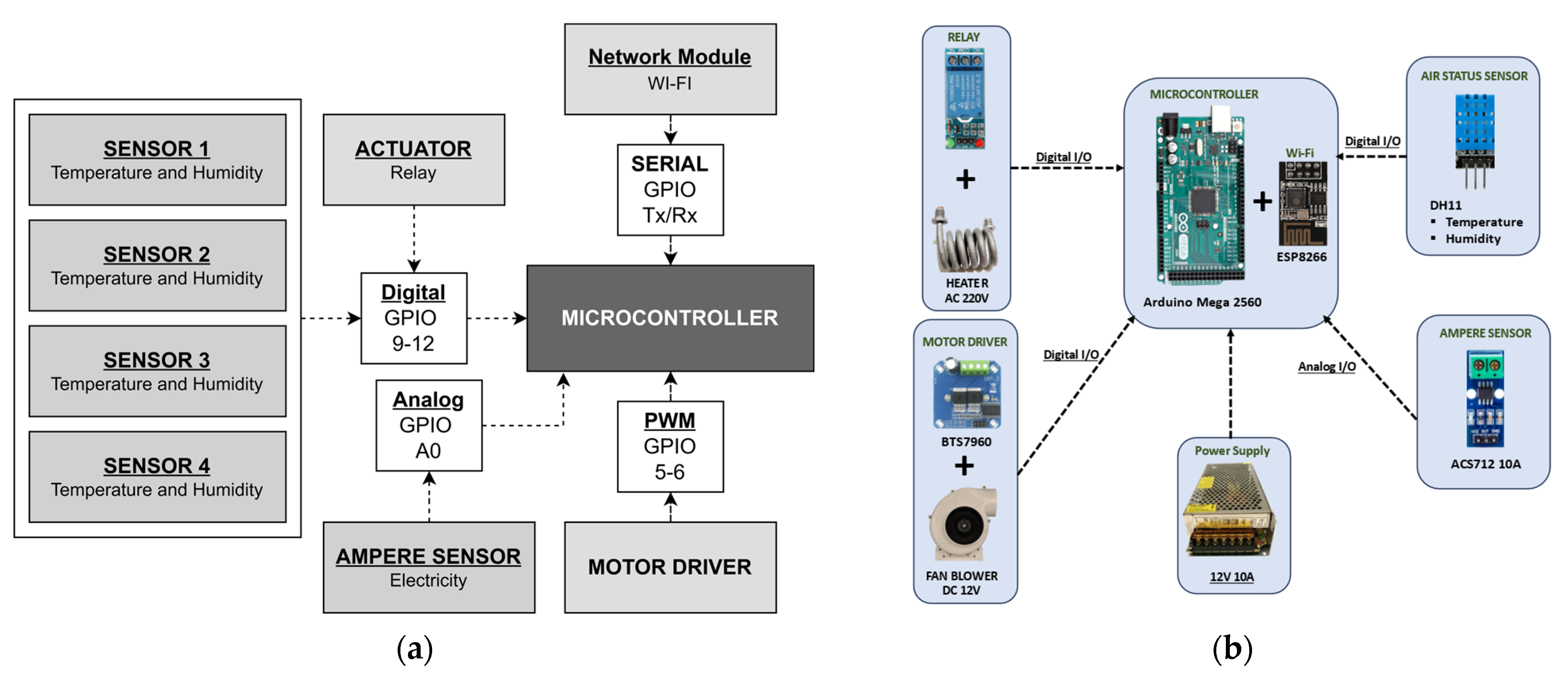
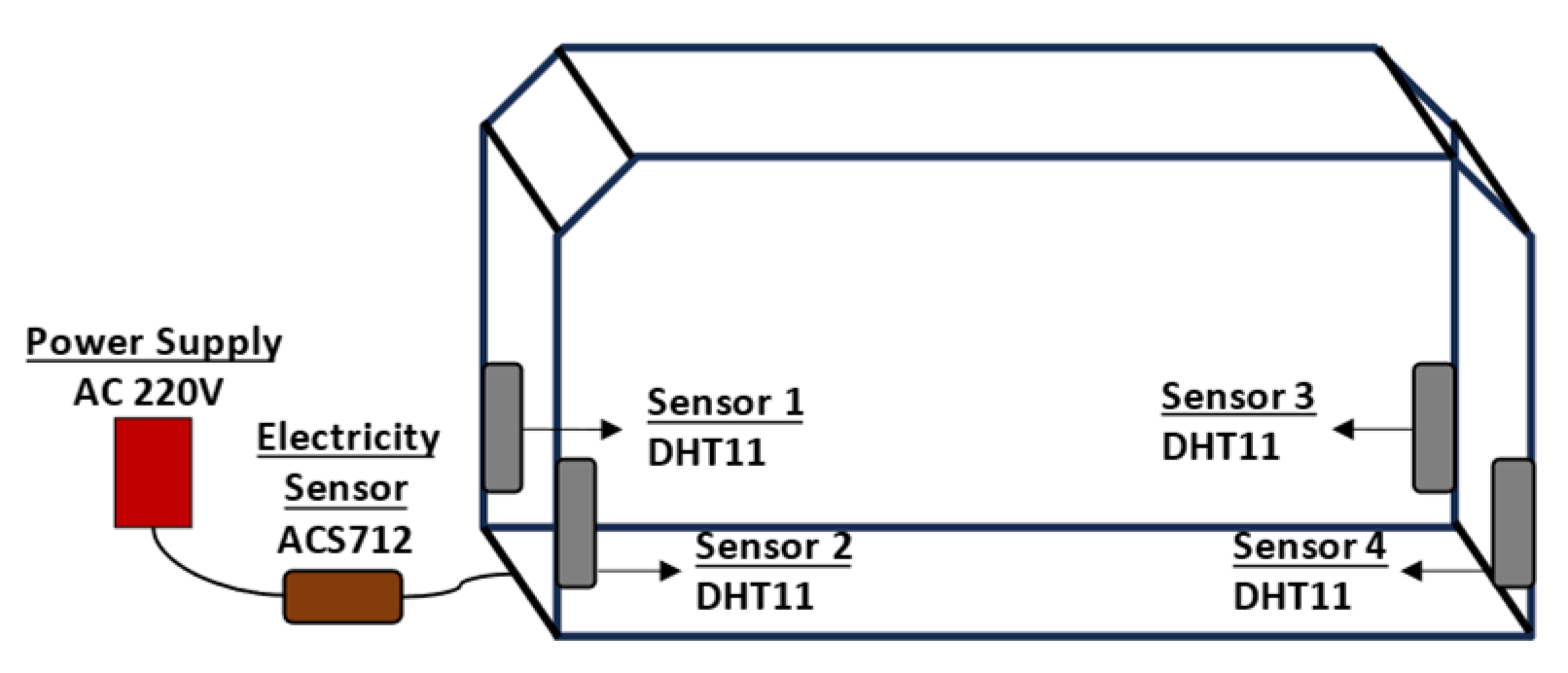



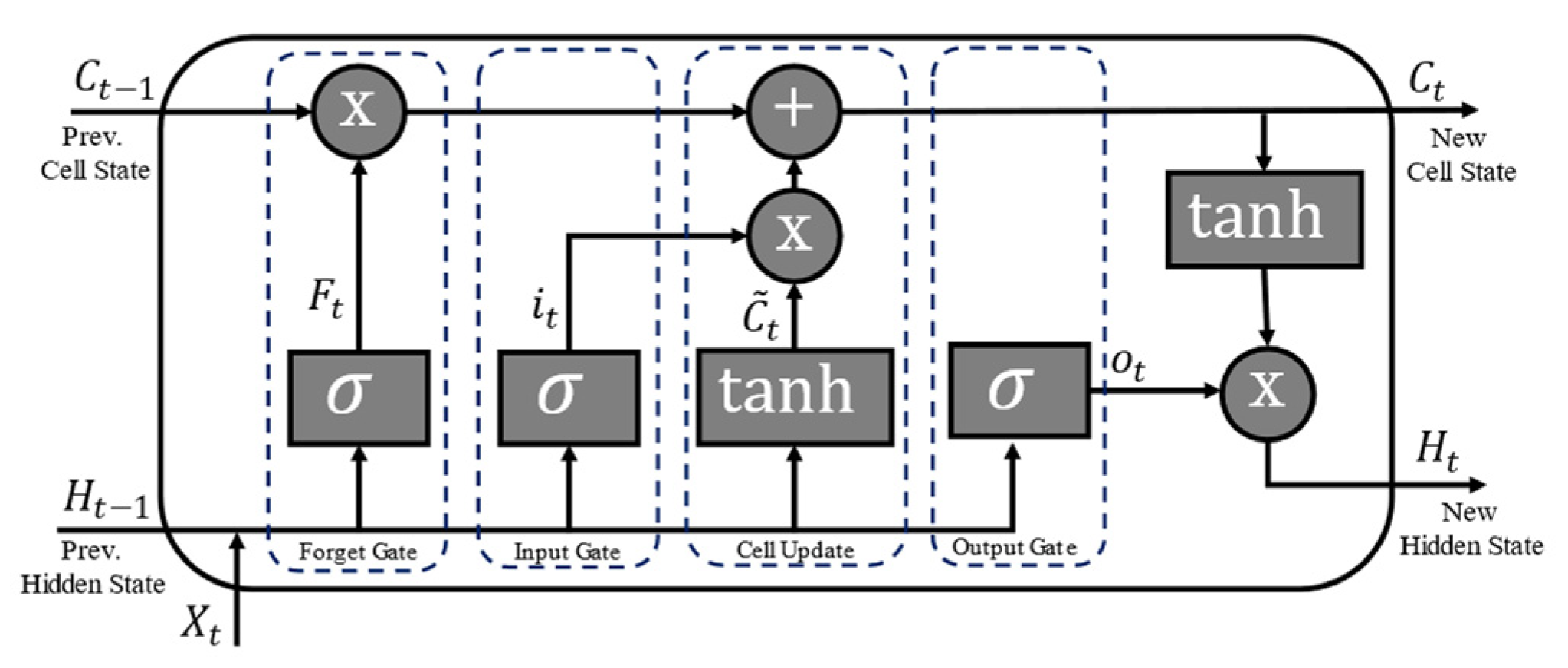
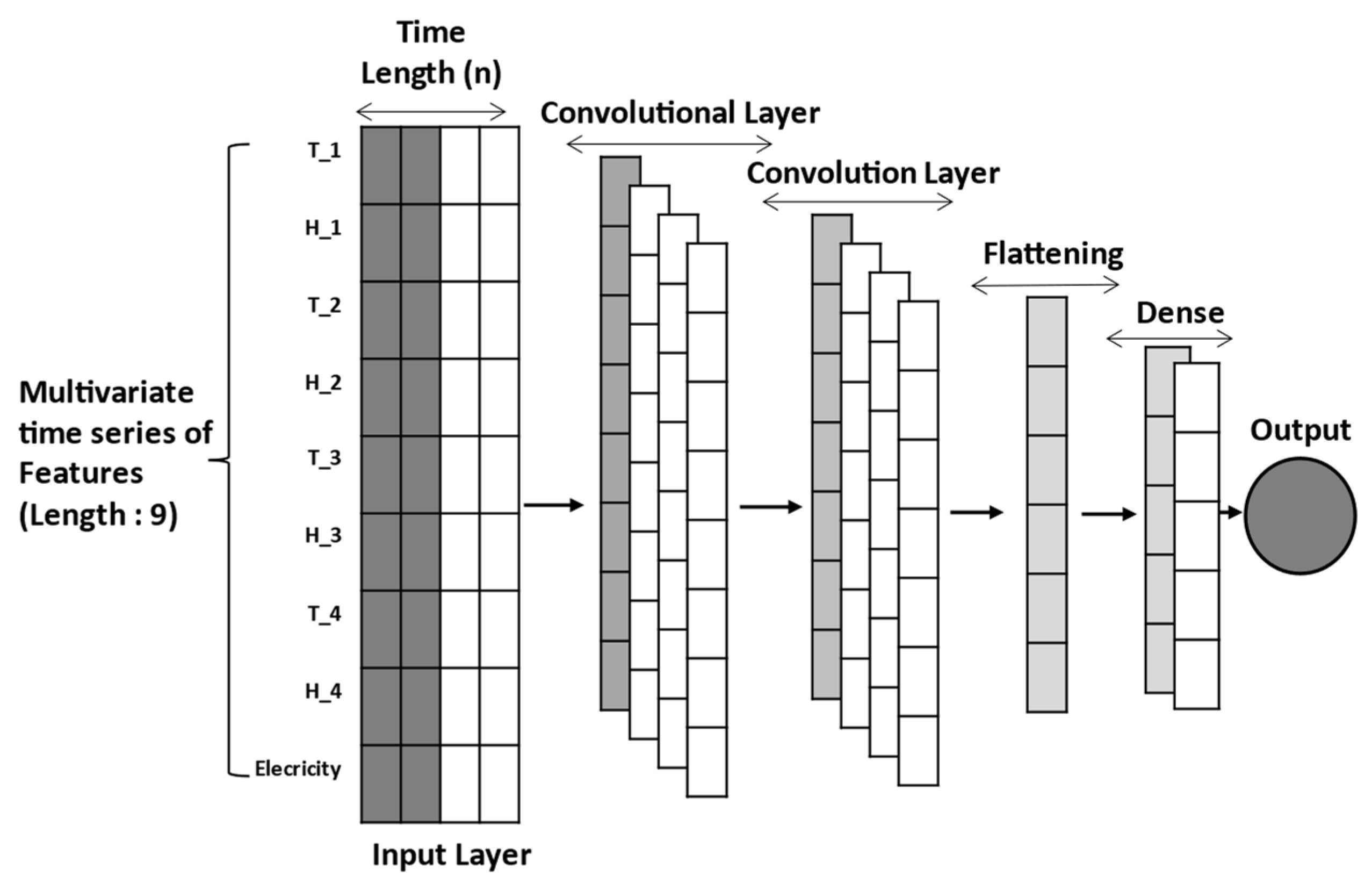
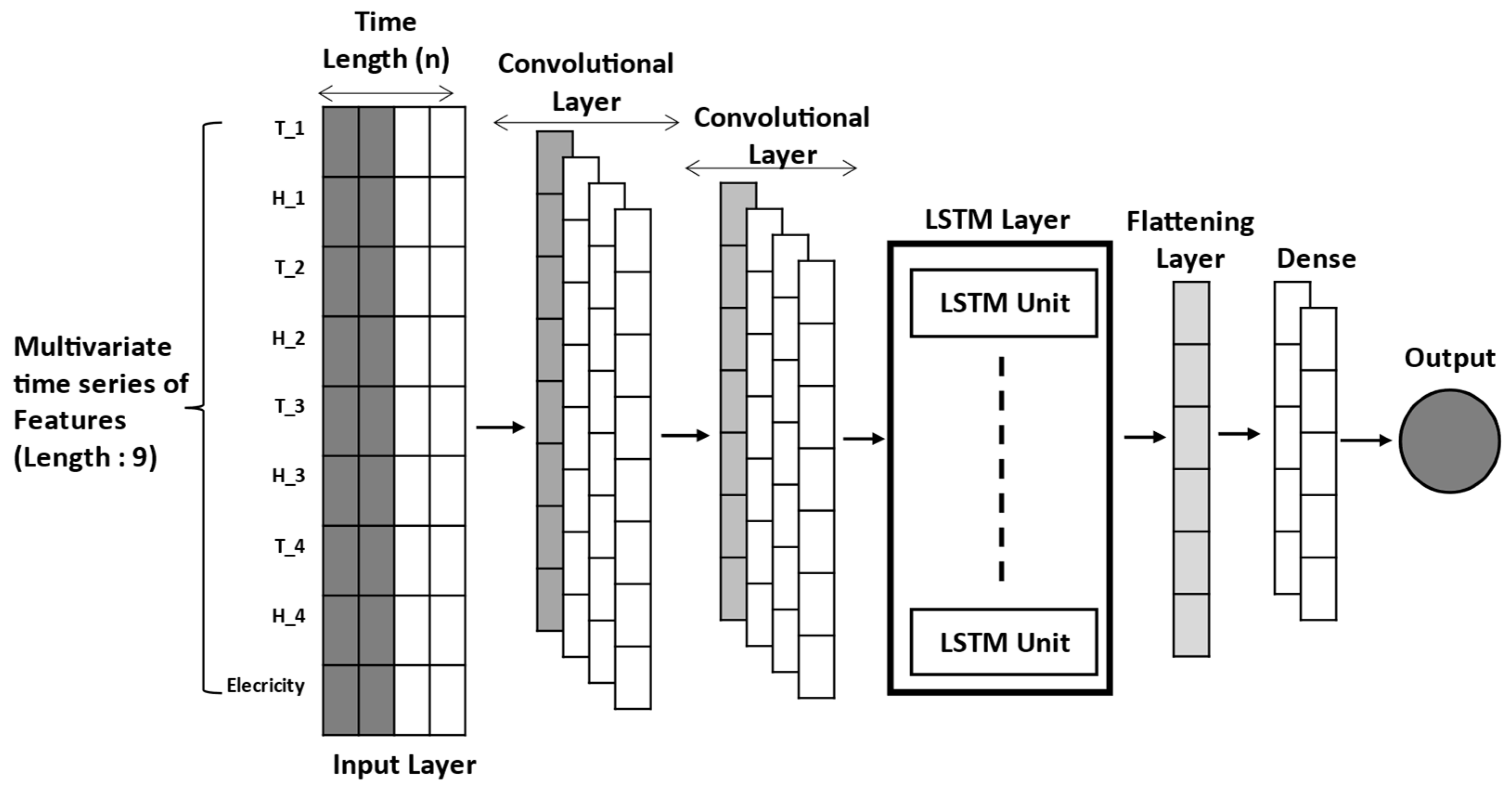


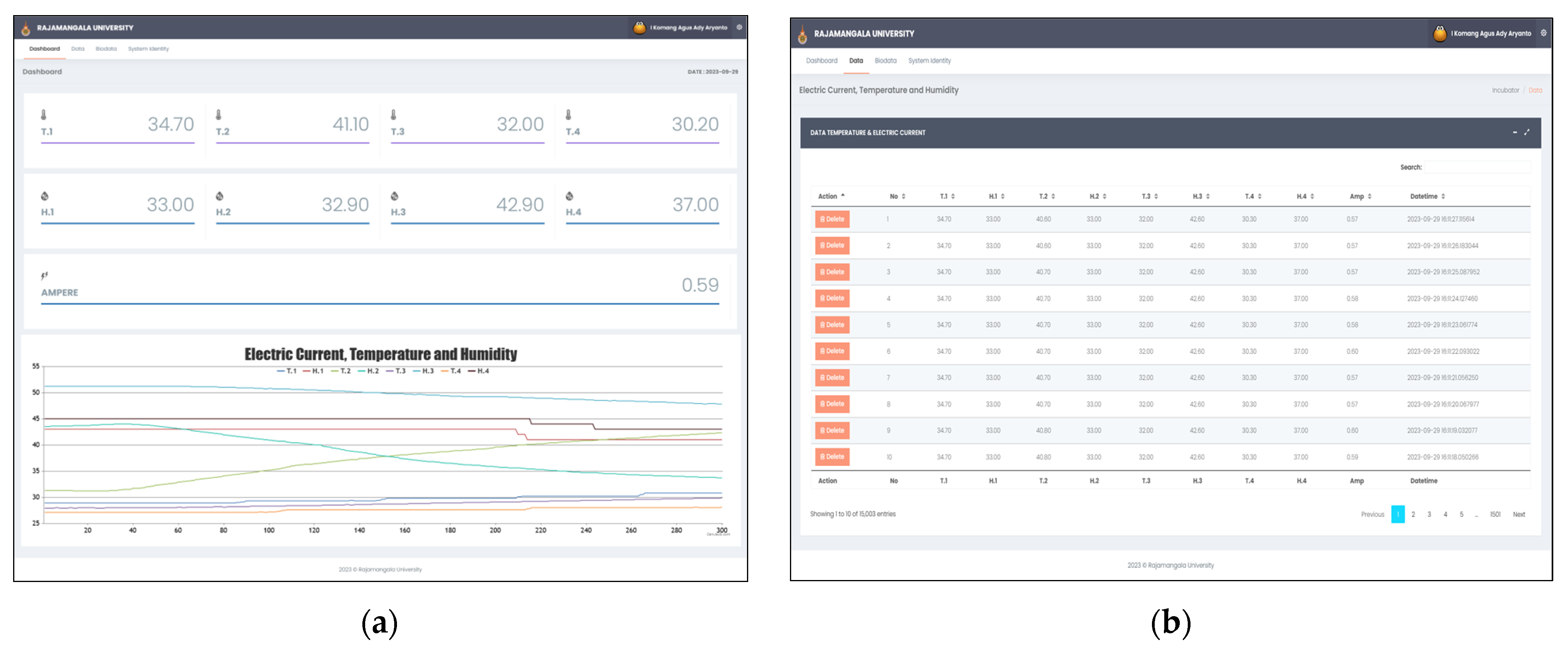
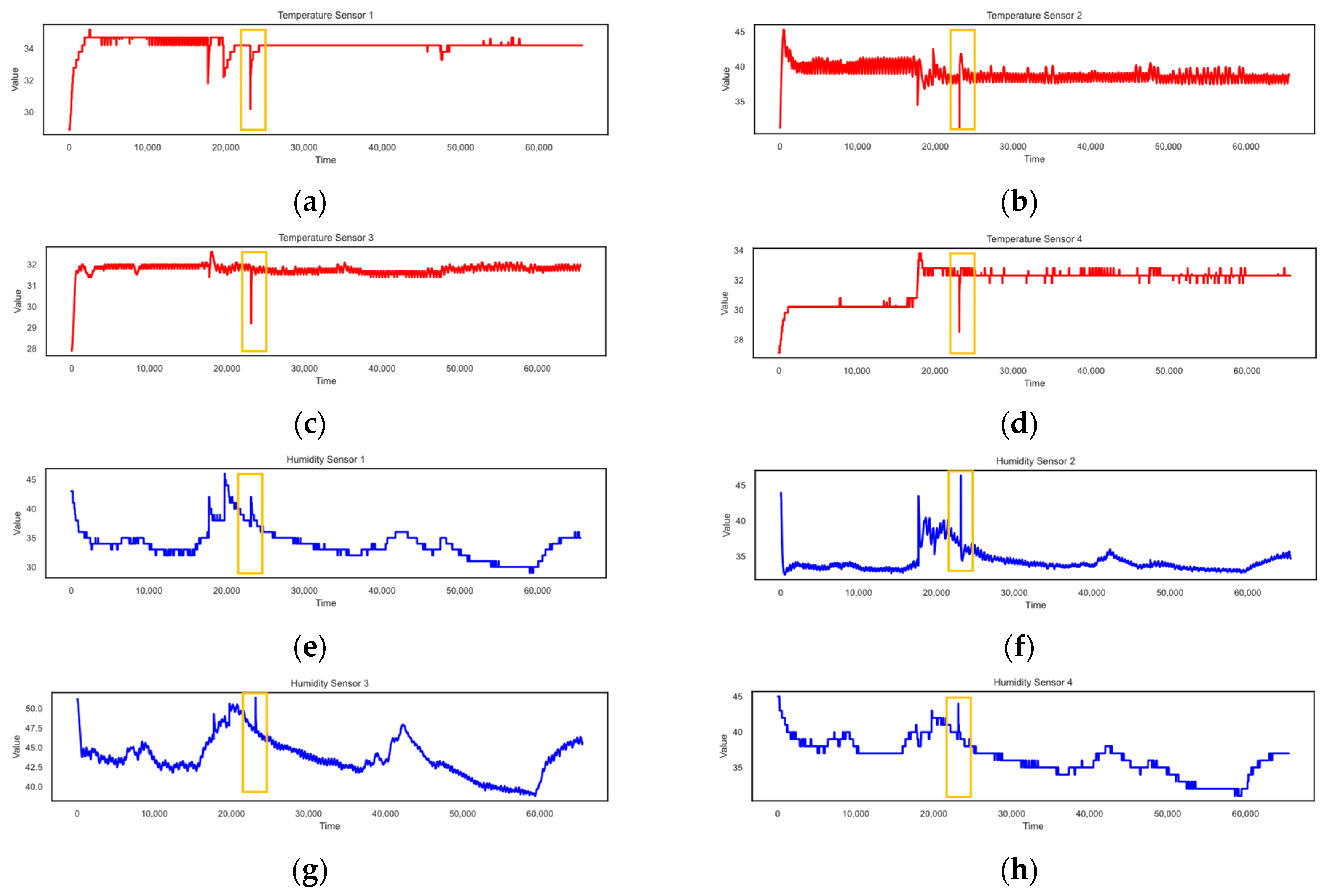

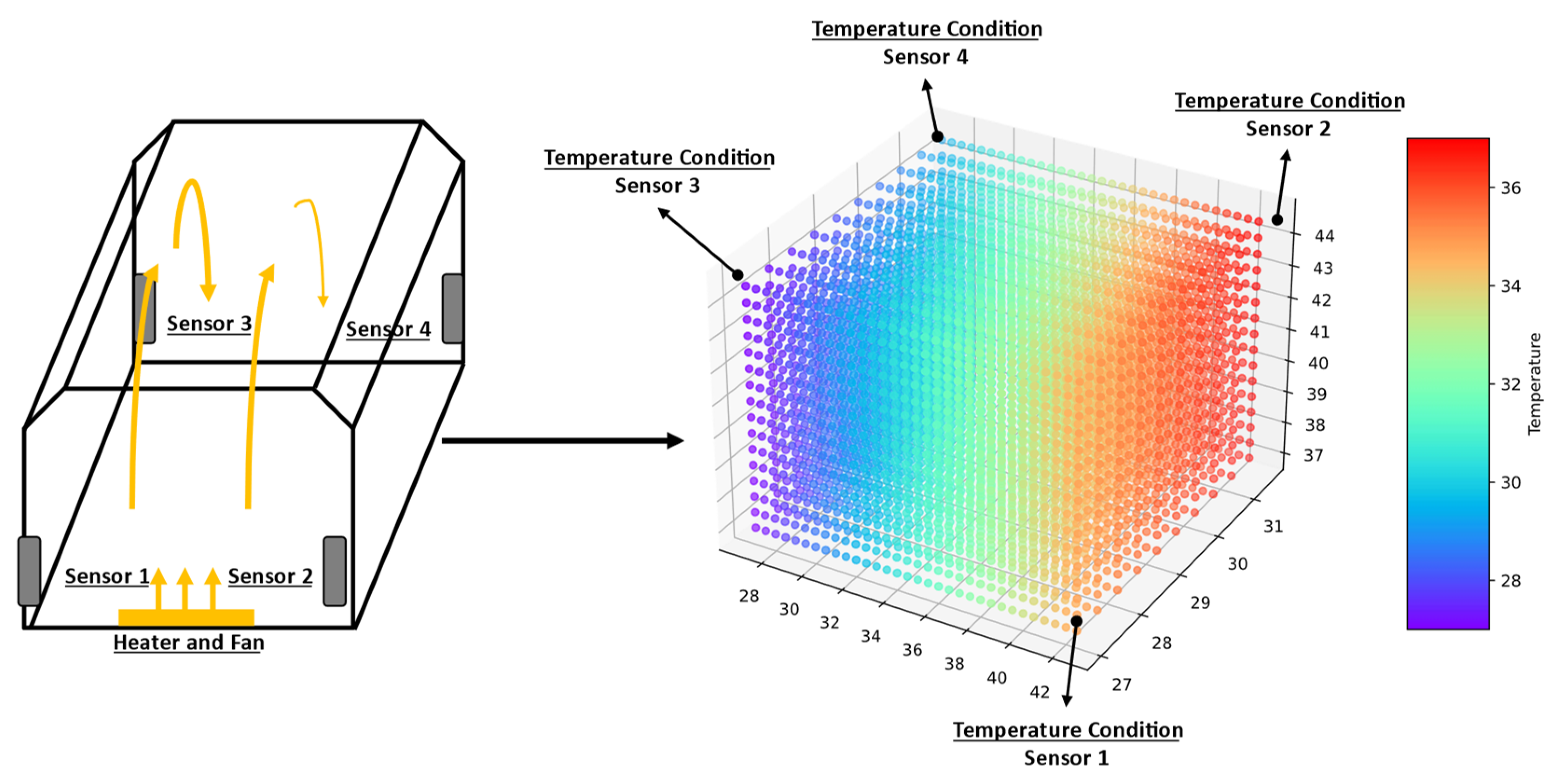






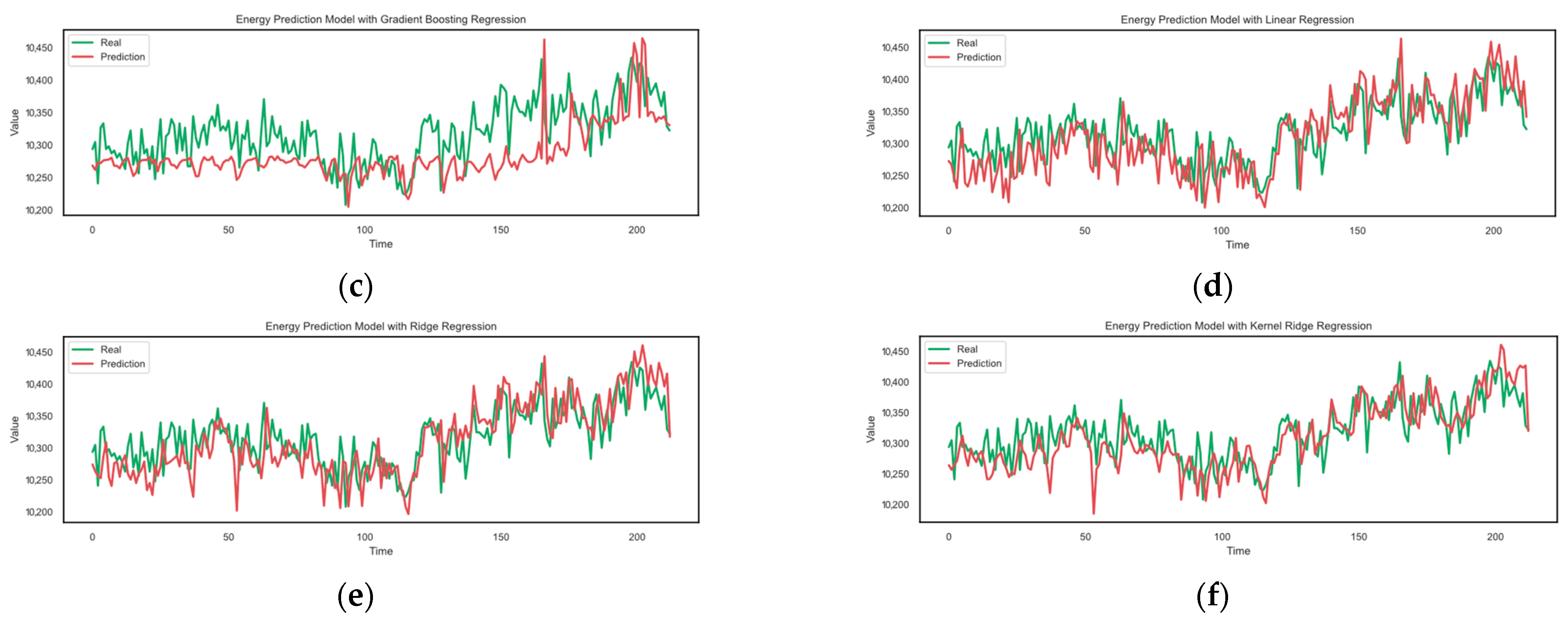
| Reference | Hardware | Network | Data | Software | Method | ||
|---|---|---|---|---|---|---|---|
| [6] | Microcontroller | ATMega 328 | Protocol | HTTP | MySQL | Mobile | - |
| Microcomputer | - | Network | GSM | ||||
| Sensor | Phototherapy, Temperature, humidity, Fingerprint, Heart Rate, Camera | Broker IoT | - | ||||
| [7] | Microcontroller | ATMega16 | Protocol | - | - | LCD, Desktop | Fuzzy-PID |
| Microcomputer | - | Network | - | ||||
| Sensor | Temperature, Humidity | Broker IoT | - | ||||
| [8] | Microcontroller | ESP32 | Protocol | MQTT | Filter, Peak Detection, Feature Extraction | LCD, Desktop | - |
| Microcomputer | Raspberry Pi | Network | WiFi | ||||
| Sensor | Respiration | Broker IoT | Mosquitto | ||||
| [9] | Microcontroller | ESP32 | Protocol | MQTT | MySQL | Web | - |
| Microcomputer | - | Network | WiFi | ||||
| Sensor | Temperature, humidity, Sound | Broker IoT | Node-Red | ||||
| Proposed work | Microcontroller | ATMega 2560 | Protocol | MQTT, HTTP | Filter, MySQL | Web, Mobile | CNN, LSTM, RMSE, MAE, MAPE, MSE |
| Microcomputer | Raspberry Pi | Network | WiFi | ||||
| Sensor | Temperature, humidity, Energy | Broker IoT | Mosquitto | ||||
| Component | Description | Qty. | Unit Price ($) | Total ($) |
|---|---|---|---|---|
| Board Arduino Mega2560 | Microcontroller | 1 | 8.65 | 8.65 |
| ESP8266 | WiFi | 1 | 0.86 | 0.86 |
| DHT11 | Temperature measurement range: 0 °C to 50 °C, and Humidity measurement range: 20% to 90% [27] | 4 | 0.60 | 2.4 |
| ACS712 10 A | Ampere sensor | 1 | 0.73 | 0.73 |
| Relay 1 channel | Relay | 1 | 0.30 | 0.3 |
| Motor DC 12 V | Motor | 1 | 15.38 | 15.38 |
| BTS7960 | Driver motor | 1 | 3.89 | 3.89 |
| Heater Incubator 1200 Watt | Heater | 1 | 115.34 | 115.34 |
| Power supply 12 V | Power supply | 1 | 8.78 | 8.78 |
| Total | 156.33 | |||
| Variable | Electronic | Data Type | Unit | Variable | Electronic | Data Type | Unit |
|---|---|---|---|---|---|---|---|
| temperature_1 | DHT11 | Float | °C | humidity_1 | DHT11 | Float | % |
| temperature_2 | DHT11 | Float | °C | humidity_2 | DHT11 | Float | % |
| temperature_3 | DHT11 | Float | °C | humidity_3 | DHT11 | Float | % |
| temperature_4 | DHT11 | Float | °C | humidity_4 | DHT11 | Float | % |
| electricity | ACS712 | Float | A | date | DS1307 | DateTime | yy:mm:dd hh:mm:ss |
| Variable | Attribute | Unit | Descriptions | Variable | Attribute | Unit | Descriptions |
|---|---|---|---|---|---|---|---|
| temperature_1 | T_1 | °C | Temperature on the right rear side | humidity_1 | RH_1 | % | Humidity on the right rear side |
| temperature_2 | T_2 | °C | Temperature on the right front side | humidity_2 | RH_2 | % | Humidity on the right front side |
| temperature_3 | T_3 | °C | Temperature on the left front side | humidity_3 | RH_3 | % | Humidity on the left front side |
| temperature_4 | T_4 | °C | Temperature on the left rear side | humidity_4 | RH_4 | % | Humidity on the left rear side |
| electricity | Electricity | A | Electrical energy usage | date | Date | yy:mm:dd hh:mm:ss | Date and time |
| Layer | Properties |
|---|---|
| 1st Convolutional | filter = 55, kernel size = 3, activation = ReLU |
| 2nd Convolutional | filter = 55, kernel size = 2, activation = ReLU |
| Flattening | - |
| Dense | unit = 10 |
| Layer | Properties |
|---|---|
| 1st Convolutional | filter = 50, kernel size = 3, activation = ReLU |
| 2nd Convolutional | filter = 50, kernel size = 2, activation = ReLU |
| 1st LSTM | unit = 50, activation = ReLU |
| 2nd LSTM | unit = 50, activation = ReLU |
| Flattening | - |
| Dense | unit = 10 |
| Variable | T_1 | T_2 | T_3 | T_4 | H_1 | H_2 | H_3 | H_4 | Ampere | Joule |
|---|---|---|---|---|---|---|---|---|---|---|
| count | 65,535 | 65,535 | 65,535 | 65,535 | 65,535 | 65,535 | 65,535 | 65,535 | 65,535 | 65,535 |
| mean | 34.22 | 39.02 | 31.76 | 31.77 | 34.03 | 34.22 | 43.76 | 36.45 | 0.73 | 161.47 |
| std | 0.48 | 1.14 | 0.27 | 1.02 | 2.62 | 1.51 | 2.47 | 2.60 | 0.09 | 21.63 |
| min | 28.90 | 31.10 | 27.90 | 27.10 | 29.00 | 32.40 | 38.80 | 31.00 | 0.45 | 99.00 |
| max | 35.20 | 45.30 | 32.60 | 33.80 | 46.00 | 46.40 | 51.40 | 45.00 | 0.92 | 202.40 |
| T_1 | H_1 | T_2 | H_2 | T_3 | H_3 | T_4 | H_4 | Ampere | Joule | |
|---|---|---|---|---|---|---|---|---|---|---|
| T_1 | 1 | −0.43 | 0.1 | −0.31 | 0.69 | −0.27 | −0.034 | −0.22 | −0.2 | −0.2 |
| H_1 | −0.43 | 1 | 0.11 | 0.79 | −0.22 | 0.94 | −0.008 | 0.87 | −0.003 | −0.003 |
| T_2 | 0.1 | 0.11 | 1 | −0.37 | 0.35 | 0.015 | −0.58 | 0.36 | −0.63 | −0.63 |
| H_2 | −0.31 | 0.79 | −0.73 | 1 | −0.22 | 0.8 | 0.3 | 0.57 | 0.29 | 0.29 |
| T_3 | 0.69 | −0.22 | 0.35 | −0.22 | 1 | −0.21 | 0.13 | −0.16 | −0.11 | −0.11 |
| H_3 | −0.27 | 0.94 | 0.015 | 0.8 | −0.21 | 1 | 0.018 | 0.86 | 0.022 | 0.022 |
| T_4 | −0.034 | −0.008 | −0.58 | 0.3 | 0.13 | 0.018 | 1 | −0.43 | 0.91 | 0.91 |
| H_4 | −0.22 | 0.87 | 0.36 | 0.57 | −0.16 | 0.86 | −0.43 | 1 | −0.42 | −0.42 |
| Ampere | −0.2 | −0.003 | −0.63 | 0.29 | −0.11 | 0.022 | 0.91 | −0.42 | 1 | 1 |
| Joule | −0.2 | −0.003 | −0.63 | 0.29 | −0.11 | 0.022 | 0.91 | −0.42 | 1 | 1 |
| Neurons LSTM-1 | Neurons LSTM-2 | Dense | Lookbacks | RMSE (Joule) | MAE (Joule) | MSE (Joule) | MAPE (%) |
|---|---|---|---|---|---|---|---|
| 5 | 5 | 10 | 5 | 47.824 | 37.945 | 0.004 | 0.4 |
| 10 | 10 | 10 | 5 | 53.587 | 42.816 | 0.004 | 0.4 |
| 15 | 15 | 10 | 5 | 60.238 | 51.231 | 0.005 | 0.5 |
| 20 | 20 | 10 | 5 | 95.778 | 87.149 | 0.008 | 0.8 |
| 25 | 25 | 10 | 5 | 83.127 | 75.284 | 0.007 | 0.7 |
| 30 | 30 | 10 | 5 | 64.154 | 52.420 | 0.005 | 0.5 |
| 35 | 35 | 10 | 5 | 42.650 | 33.574 | 0.003 | 0.3 |
| 40 | 40 | 10 | 5 | 72.566 | 57.842 | 0.006 | 0.6 |
| 45 | 45 | 10 | 5 | 64.616 | 54.205 | 0.005 | 0.5 |
| 50 | 50 | 10 | 5 | 60.420 | 49.234 | 0.005 | 0.5 |
| 55 | 55 | 10 | 5 | 67.376 | 55.351 | 0.005 | 0.5 |
| 60 | 60 | 10 | 5 | 53.054 | 42.452 | 0.004 | 0.4 |
| 65 | 65 | 10 | 5 | 47.793 | 38.947 | 0.004 | 0.4 |
| 70 | 70 | 10 | 5 | 68.445 | 54.603 | 0.005 | 0.5 |
| Neurons CNN-1 | Neurons CNN-2 | Dense | Lookbacks | RMSE (Joule) | MAE (Joule) | MSE (Joule) | MAPE (%) |
|---|---|---|---|---|---|---|---|
| 5 | 5 | 10 | 5 | 85.404 | 67.058 | 0.007 | 0.7 |
| 10 | 10 | 10 | 5 | 41.459 | 33.377 | 0.003 | 0.3 |
| 15 | 15 | 10 | 5 | 38.380 | 30.588 | 0.003 | 0.3 |
| 20 | 20 | 10 | 5 | 45.492 | 36.244 | 0.004 | 0.4 |
| 25 | 25 | 10 | 5 | 41.660 | 33.074 | 0.003 | 0.3 |
| 30 | 30 | 10 | 5 | 37.873 | 30.209 | 0.003 | 0.3 |
| 35 | 35 | 10 | 5 | 47.039 | 37.867 | 0.004 | 0.4 |
| 40 | 40 | 10 | 5 | 59.837 | 48.592 | 0.005 | 0.5 |
| 45 | 45 | 10 | 5 | 61.525 | 51.413 | 0.005 | 0.5 |
| 50 | 50 | 10 | 5 | 45.261 | 35.964 | 0.003 | 0.3 |
| 55 | 55 | 10 | 5 | 37.675 | 30.082 | 0.003 | 0.3 |
| 60 | 60 | 10 | 5 | 70.768 | 62.246 | 0.006 | 0.6 |
| 65 | 65 | 10 | 5 | 46.593 | 37.493 | 0.004 | 0.4 |
| 70 | 70 | 10 | 5 | 50.010 | 40.676 | 0.004 | 0.4 |
| Neurons CNN-1 | Neurons CNN-2 | Neurons LSTM-1 | Neurons LSTM-2 | Lookbacks | RMSE (Joule) | MAE (Joule) | MSE (Joule) | MAPE (%) |
|---|---|---|---|---|---|---|---|---|
| 5 | 5 | 5 | 5 | 5 | 53.678 | 43.037 | 0.004 | 0.4 |
| 10 | 10 | 10 | 10 | 5 | 38.052 | 30.266 | 0.003 | 0.3 |
| 15 | 15 | 15 | 15 | 5 | 53.819 | 43.775 | 0.004 | 0.4 |
| 20 | 20 | 20 | 20 | 5 | 56.922 | 46.486 | 0.005 | 0.5 |
| 25 | 25 | 25 | 25 | 5 | 55.123 | 43.133 | 0.004 | 0.4 |
| 30 | 30 | 30 | 30 | 5 | 51.156 | 40.531 | 0.004 | 0.4 |
| 35 | 35 | 35 | 35 | 5 | 52.600 | 44.532 | 0.004 | 0.4 |
| 40 | 40 | 40 | 40 | 5 | 43.773 | 35.523 | 0.003 | 0.3 |
| 45 | 45 | 45 | 45 | 5 | 64.274 | 51.416 | 0.005 | 0.5 |
| 50 | 50 | 50 | 50 | 5 | 32.436 | 25.382 | 0.002 | 0.2 |
| 55 | 55 | 55 | 55 | 5 | 44.562 | 36.165 | 0.004 | 0.4 |
| 60 | 60 | 60 | 60 | 5 | 40.758 | 32.583 | 0.003 | 0.3 |
| 65 | 65 | 65 | 65 | 5 | 46.439 | 37.802 | 0.004 | 0.4 |
| 70 | 70 | 70 | 70 | 5 | 115.992 | 96.323 | 0.009 | 0.9 |
| Method | RMSE (Joule) | MAE (Joule) | MSE (Joule) | MAPE (%) |
|---|---|---|---|---|
| Elastic Net Regression | 274.217 | 272.205 | 0.026 | 2.6 |
| Support Vector Regression | 82.572 | 69.823 | 0.007 | 0.7 |
| Gradient Boosting Regression | 51.213 | 41.882 | 0.004 | 0.4 |
| Linear Regression | 43.438 | 34.700 | 0.003 | 0.3 |
| Ridge Regression | 41.258 | 32.404 | 0.003 | 0.3 |
| Kernel Ridge Regression | 38.758 | 29.841 | 0.003 | 0.3 |
| CNN-LSTM | 32.436 | 25.382 | 0.002 | 0.2 |
Disclaimer/Publisher’s Note: The statements, opinions and data contained in all publications are solely those of the individual author(s) and contributor(s) and not of MDPI and/or the editor(s). MDPI and/or the editor(s) disclaim responsibility for any injury to people or property resulting from any ideas, methods, instructions or products referred to in the content. |
© 2023 by the authors. Licensee MDPI, Basel, Switzerland. This article is an open access article distributed under the terms and conditions of the Creative Commons Attribution (CC BY) license (https://creativecommons.org/licenses/by/4.0/).
Share and Cite
Aryanto, I.K.A.A.; Maneetham, D.; Crisnapati, P.N. Enhancing Neonatal Incubator Energy Management and Monitoring through IoT-Enabled CNN-LSTM Combination Predictive Model. Appl. Sci. 2023, 13, 12953. https://doi.org/10.3390/app132312953
Aryanto IKAA, Maneetham D, Crisnapati PN. Enhancing Neonatal Incubator Energy Management and Monitoring through IoT-Enabled CNN-LSTM Combination Predictive Model. Applied Sciences. 2023; 13(23):12953. https://doi.org/10.3390/app132312953
Chicago/Turabian StyleAryanto, I Komang Agus Ady, Dechrit Maneetham, and Padma Nyoman Crisnapati. 2023. "Enhancing Neonatal Incubator Energy Management and Monitoring through IoT-Enabled CNN-LSTM Combination Predictive Model" Applied Sciences 13, no. 23: 12953. https://doi.org/10.3390/app132312953
APA StyleAryanto, I. K. A. A., Maneetham, D., & Crisnapati, P. N. (2023). Enhancing Neonatal Incubator Energy Management and Monitoring through IoT-Enabled CNN-LSTM Combination Predictive Model. Applied Sciences, 13(23), 12953. https://doi.org/10.3390/app132312953





